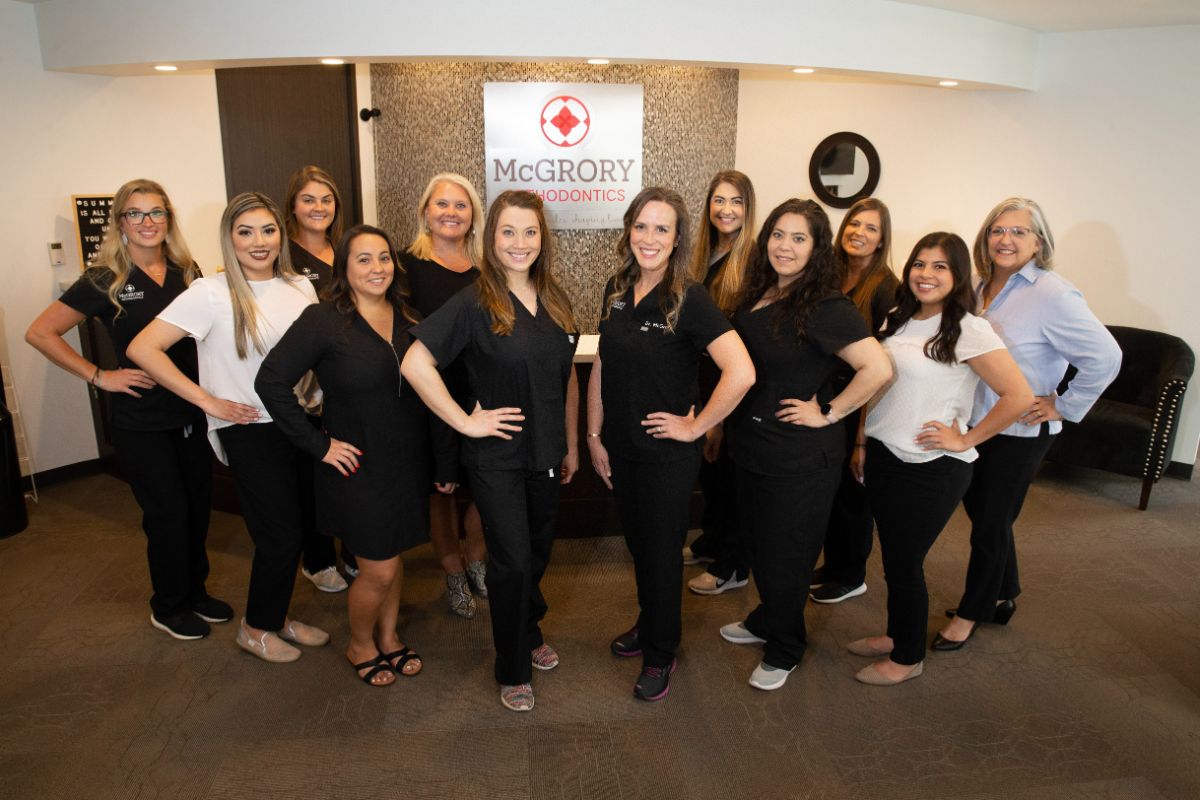Here at McGrory Orthodontics, we know how much hard work goes into completing your treatment. There are guidelines, rules, recommendations, restrictions—but now you’ve made it! Your braces are coming off or you’ve used your last aligner, and we’re proud of you for taking such good care of your teeth as we worked to straighten them. Finishing up the active phase of treatment is certainly worth celebrating, but the final phase is still ahead: retention!
The retention phase rounds out your orthodontic journey and ensures your newly straightened smile stays in place. You’ve undoubtedly heard us mention time and time again that it’s important to wear the retainer we give you once treatment is complete. You may still be a little fuzzy on the details, however.
Retention revolves around the future of your smile and now is the perfect time to take a closer look at this valuable orthodontic tool. To learn more about the basics of retention, the different types of retainers available, and why regular use is the key to long-lasting results, keep reading below!
Why do retainers matter so much?
In a perfect world, the results of orthodontic treatment would last forever. Unfortunately, a phenomenon known as relapse gets in the way of that. This describes the natural tendency of the teeth to drift back toward their original positions as we age. Relapse generally begins in the late teens or early twenties and can occur even if you’ve completed orthodontic treatment. Retainers are the easiest and most effective way to prevent this process by holding your teeth in their new positions.
The next part is a little technical, but don’t panic! We’ll keep it quick and simple. To get a good grasp on why retainers are so important, we need to look at a few facts about teeth. For example, teeth aren’t just fixtures in the jaw—each one is held in its socket by elastic ligaments that attach the roots to the bone. These ligaments are living tissues that are affected by the movement of the teeth, and it’s this attachment that allows for the small movements of the teeth during treatment.
We use appliances like braces and aligners to place tension in and around the teeth. This is known as the remodeling phase of treatment, and it facilitates the formation of new ligaments and sometimes bone. Once this is complete, the newly formed tissues, ligaments, and bone need time to stabilize. This happens in part during the retention phase. If there’s nothing to hold the teeth in place during this phase, they will almost always migrate back to their old positions.
You may be wondering what that means for you! To put it simply, if you don’t wear your retainer as recommended by Dr. McGrory or Dr. McCarty, your teeth will eventually begin shifting back to their old positions. Fortunately, keeping your teeth in place is as simple as wearing your retainer regularly!

The different types of retainers
Once your treatment is complete, Dr. McGrory will choose the best type of retainer for you based on your specific needs, preferences, and expected compliance. Our practice offers patients fixed orthodontic appliances like braces and removable appliances like Invisalign® clear aligners. We have the same flexibility when it comes to retainers! Here’s a look at the different types available.
Fixed retainers
Fixed retainers generally consist of a thin wire that’s bonded behind the bottom or top teeth, or sometimes both. These can be a particularly helpful option for patients who have (or have had) a large space between the two upper front teeth. Once treatment is complete and the space is completely closed, a fixed retainer can be used to keep it that way.
Since the wire stretches across several teeth, dental hygiene is similar to that of a braces patient. If you have a fixed retainer, you’ll need to be especially careful with brushing and flossing to ensure it stays clean. Because the bonded wire holds your newly straightened teeth in the ideal alignment over a long time, fixed retainers often have excellent outcomes. And as a bonus, you never have to remember to wear them!
Removable retainers
When it comes to removable retainers, there are a couple of different options available. The Hawley and Essix models are both custom-designed to fit your mouth for the best results. When you complete the active phase of treatment, our team will take an impression of your newly straightened teeth and use this to create your retainer.
Hawley retainers
Hawley retainers are one of the oldest types of retainers. They’re made of stainless steel and kept in place by wrapping a wire around your teeth. That wire has been combined with an acrylic arch that rests against the roof of your mouth, and it can be adjusted to continue minor movement of the front teeth if needed. While many orthodontists are moving away from using Hawley retainers, they can still be useful in certain cases.
Essix retainers
Essix retainers look very similar to the clear aligners used with the Invisalign system. They’re made entirely of transparent plastic and molded to the unique shape of the patient’s mouth. Essix retainers may cover the entire arch of the teeth or only go from canine to canine. This type of retainer is very subtle and should last as long as you need it, provided you care for it properly.
Cleaning your teeth is easier with removable retainers, but you will have to remember to wear them daily. They can be pretty easy to misplace or damage, so you’ll also need to be mindful of where it is at all times and be careful when handling it.

Ensure a lifetime of straight smiles with help from McGrory Orthodontics
Here’s an interesting fact: in the first year post-treatment, your teeth can begin shifting back to their old positions in as little as a few days. If you don’t wear your retainer regularly, this drifting will continue, undoing all your hard work eventually. Using your retainer responsibly will keep your smile on the straight and narrow for years to come!
The latest orthodontic guidance tells us that most patients will need to wear some type of retainer indefinitely for the best results, but don’t let that worry you! Your retainer will become just another part of your daily routine before you know it. Do you have questions about retainers or the retention phase? Get in touch with our Pearland or Bellaire office today! We’ll be happy to walk you through any concerns you have and help ensure a lifetime of healthy smiles for you.
